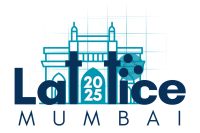Speaker
Description
Strong magnetic fields can profoundly affect the equilibrium properties, characterized by the equation of state and bulk thermodynamics of strongly interacting matter. Although such fields are expected in off-central heavy-ion collisions, directly measuring their experimental imprints remains extremely challenging. To address this, in this talk we propose the baryon-electric charge correlations $\chi^{\rm BQ}_{11}$ and the chemical potential ratio $\mu_{\rm Q}/\mu_{\rm B}$ as magnetic-field-sensitive probes, based on (2+1)-flavor QCD lattice simulations at physical pion masses. Along the transition line, $\chi^{\rm BQ}_{11}$ and $(\mu_{\rm Q}/\mu_{\rm B})_{\rm LO}$ in Pb--Pb collisions increase by factors of 2.1 and 2.4 at $eB \simeq 8M_\pi^2$, respectively. To bridge theoretical predictions and experimental observations, we construct HRG-based proxies and apply systematic kinematic cuts to emulate STAR and ALICE detector acceptances. Furthermore, extending this investigation, we discuss the QCD equation of state and examine the leading-order thermodynamic coefficients for strangeness-neutral scenarios up to $eB \simeq 0.8 {\rm GeV}^2 \sim 45 m_{\pi}^2$, revealing intriguing non-monotonic structures.
| Parallel Session (for talks only) | QCD at nonzero temperature and density |
|---|

